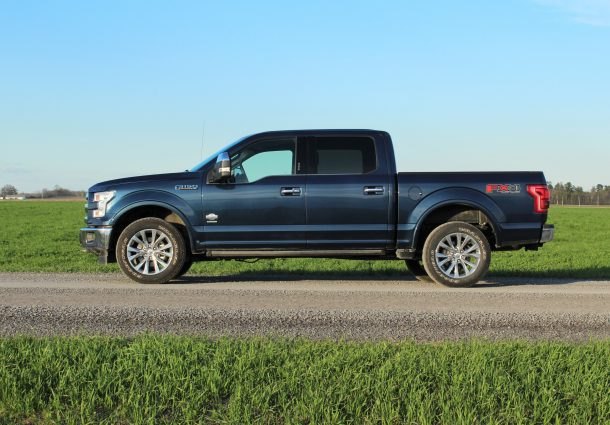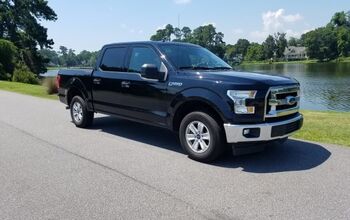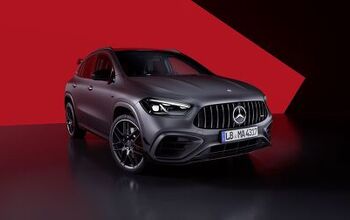2017 Ford F-150 4×4 King Ranch Review - Southfork Living

2017 Ford F-150 4x4 King Ranch
It’s better than a 1937 Nash Lafayette, though fuel economy — in real world driving — seems to be slightly less, if I’m to believe the results of the Mobilgas Economy Run.
I’m referring to my great-grandfather’s 1937 (or ’38) Lafayette, a fixture of my mother’s otherwise carless childhood in postwar Baby Boom Alberta. What brought up this unlikely comparison, you ask? What could a technology-laden 2017 Ford F-150 King Ranch pickup possibly have in common with a six-cylinder Depression-era sedan?
Running boards. In my mother’s earliest memories, the running boards of her granddad’s car were fixed, spanning the distance between two fenders dulled by Prairie dust and providing easy access to the spartan cabin of a long-lived touring car. In the Ford’s case, they’re electrically operated, lowering into place upon the opening of any of the pickup’s doors, then receding out of sight below the rockers, propelled by engineering ingenuity and cash.
It’s an option I’ve always found ridiculous, especially in a climate where road salt is a depressing reality. I like a fixed board. Nothing fancy. However, to my mom, who I chauffeured to a Mother’s Day meal in the King Ranch, that feature alone was enough to make her consider pulling a bank job to meet the truck’s MSRP.
With this particular truck, payload capacity and off-road prowess is an afterthought.
Who else absolutely loved the King Ranch? Well, my sister, who delighted in the optional dual sunroofs (and aforementioned running boards). Frankly, everyone — myself included — appreciated the genuine wood trim, which glowed with the rich amber hue of aged bourbon and blended well with the vehicle’s Mesa Brown leather. To warrant its price tag, traditional luxury flourishes are a must, even in a truck.
Let’s not forget my two nephews, who made the SuperCrew cabin’s spacious backseat their own personal playground, leaving me in mortal terror of a pebble lodged in a shoe tread scoring the leather. This ain’t a vinyl-clad XL. Every jack and plug they could desire awaited them on the center console, had they thought to bring a laptop or tablet.
We could have made smoothies together.
Yes, crew cab trucks have come a long way since being the domain of construction workers and logging crews, and with good reason: the buying public demands it. If you can afford to fuel up the beast, who doesn’t want to command the road (and weather and terrain) from a lofty and plush pickup perch?
To be fair, the King Ranch sits well below the summit of F-150 luxury (Platinum and Limited hold the No. 1 and 2 spots), though its U.S. MSRP of $55,505 (a whopping $67,099 north of the border) after delivery sits on the exclusive side of a significant price threshold. In Canada, where the price is currently subject to a $7,500 delivery allowance, the King Ranch trim is only available with four-wheel drive. This tester inflated the trim’s lofty price tag by over $14,000 CAD through the addition of almost every available option, topping out at $82,469 CAD ($68,250 USD) after delivery — basically, a Limited experience in J.R. Ewing-approved surroundings.
While some of those options — glass canopy, magic running boards and chrome, chrome, chrome — amount to non-essential ego food, a number of add-ons served a more useful purpose. First and foremost was an available powertrain upgrade that makes this vehicle a class-leader in technology.
The F-150’s 3.5-liter Ecoboost V6 has received a power boost for 2017, upping horsepower to 375 and torque to 470 lb-ft — more than enough for serious towing, which this vehicle was outfitted to do. Harnessing that power is a new 10-speed automatic jointly developed by GM and Ford. The 10-speed is one smooth unit, delivering multi-cog downshifts without abruptness or hunting, and upshifting quickly (while always skipping 2nd gear) in a bid to seek out elusive fuel economy. Poking about at 20 miles per hour, the F-150’s tranny has already achieved 6th gear. At 40 mph, it’s in 8th. The lofty 10th gear can be accessed at speeds as low as 44 mph.
(Does the wide gear ratio spread actually result in improved fuel economy? More on that later.)
While gee-whiz luxury items are nice to have, it’s the gadgets designed to keep you out of trouble that hold the greatest value. Among the options on this tester were blind spot monitoring, adaptive cruise control, and a 360-degree camera with split-screen display (among a myriad of standard safety aids) — all designed to keep insurance adjusters at bay.
If all those exterior views, plus the massive split side mirrors, aren’t enough to guide you into a parking spot, Ford’s Active Park Assist will take over the job. To date, no pickup feature wows quite like a seemingly possessed steering wheel. Out of sight below the pickup, the optional FX4 Off-Road Package quietly kept the King Ranch’s vulnerable (and expensive) underbelly shielded from angry rocks.
One person particularly enamored with the King Ranch was my godson’s dad, who, on the first day I had this tester, compelled me to haul a 15-foot T-Rex in its 5.5-foot bed. You get requests like this the moment friends hear you’re no longer driving a compact car. It’s just the way it is. However, the optional side steps and Ford’s available pull-put tailgate step came in handy for this awkward task, as did the airport runway-levels of available lighting sources.
The laws of science demanded our dino friend overhang the bed just a wee bit, as you can see below.
On the road, the King Ranch performed admirably when I wasn’t monitoring dinosaur tail positioning or answering “What does that do?” Power was plentiful and, thanks to the slick tranny, I wasn’t left waiting for that kickdown punch. Nor is the Ecoboost slow to spool up its turbines.
That said, the start/stop system, given the size of engine being jolted to life, made itself more conspicuous than desired. A kill switch allows anyone to remove this fuel-saving annoyance from their lives. I kept it activated. Suffice it to say, Ford’s Sync 3 remains light years ahead of past Blue Oval infotainment systems, and the pickup gets top marks for logical button and switch placement, as well as the instrument cluster display’s ease of use.
No driver who finds themselves behind the wheel of this particular truck will want for comfort. Frankly, I find it difficult to believe anyone could be unsettled on this infinitely adjustable leather. While the worst roads did make themselves felt in the cabin, the suspension adequately tamed the rest. I should point out that while the aluminum body exhibited no rattles, creaks, or groans, the far-right dash-mounted vent cover kept up quite a squeaky symphony. Irksome, that.
Unfortunately, no opportunities arose to test the King Ranch’s rock-crawling abilities or hill descent prowess. And, at over $82,000, I’d probably need a white pill with a name ending in “pam” before attempting such a feat. I did journey down a remote Quebec logging road, however — the sole instance the pickup’s transfer case found itself in four-wheel high — with zero drama. Not that you’d expect any in truck-friendly environs like that.
In fact, the only real surprise turned out to be the fuel economy. This particular tester carried an EPA rating of 17 miles per gallon in the city, 23 on the highway and 20 combined. After a week of highway-heavy driving, and with at least half a mind on frugality, the combined mileage returned was 17.4 mpg.
For all the wizardry going on below the hood, that’s a touch disappointing. To compare, the King Ranch’s standard 5.0-liter V8 is rated at 15 city/21 highway/17 combined. At least the Ecoboost takes regular unleaded.
While this rig’s lofty sticker price is far removed from the average buyer’s budget, its content and capabilities show just how far the domestic truck has come — and just how far automakers are willing to go to satisfy every whim of the buying public. Trucks make money, and high-zoot models like this rake it in with meatier hands.
It’s too bad about the fuel economy. Still, buyers with easy access to 80-plus grand aren’t likely to find themselves concerned with the cost of filling a 36-gallon tank. In King Ranch country, the drivers are also more than likely to have something small and sporty on the side. I believe, in J.R.’s case, it was an Allanté.
[Images: © 2017 Steph Willems/The Truth About Cars]

More by Steph Willems
Latest Car Reviews
Read moreLatest Product Reviews
Read moreRecent Comments
- CanadaCraig My 2006 300C SRT8 weighs 4,100 lbs. The all-new 2024 Dodge Charge EV weighs 5,800 lbs. Would it not be fair to assume that in an accident the vehicles these new Chargers hit will suffer more damage? And perhaps kill more people?
- Akila Hello Everyone, I found your blog very informative. If you want to know more about [url=
- Michael Gallagher I agree to a certain extent but I go back to the car SUV transition. People began to buy SUVs because they were supposedly safer because of their larger size when pitted against a regular car. As more SUVs crowded the road that safety advantage began to dwindle as it became more likely to hit an equally sized SUV. Now there is no safety advantage at all.
- Probert The new EV9 is even bigger - a true monument of a personal transportation device. Not my thing, but credit where credit is due - impressive. The interior is bigger than my house and much nicer with 2 rows of lounge seats and 3rd for the plebes. 0-60 in 4.5 seconds, around 300miles of range, and an e-mpg of 80 (90 for the 2wd). What a world.
- Ajla "Like showroom" is a lame description but he seems negotiable on the price and at least from what the two pictures show I've dealt with worse. But, I'm not interested in something with the Devil's configuration.









































Comments
Join the conversation
I live less than ten minutes from the real Southfork Ranch, and lately I'm seeing way more Platinum F-150s than King Ranch models. What is the sales by trim level, or does Ford break this out? On another note, my kids' high school has been been for several years holding their senior prom at Southfork, in the conference/event center, but they've now outgrown the place, so prom will be somewhere else next year.
Seeking Scalable, Cost-effective Reductions in Gasoline Demand and Tailpipe Emissions: Focus on Pickup Trucks, Not Priuses: (https://www.bakerinstitute.org/research/how-improved-pickups-can-save-more-fuel-priuses) Author Gabriel Collins states, "For every 100 miles driven, improving the fuel economy of a single Ford F-150 by five miles per gallon can theoretically achieve the same volumetric gasoline savings that would be accomplished by making a six-miles-per-gallon improvement to six Priuses" Just throwing this out there because I think the re-sale value of these will tank 15 years from now. Do your own DD.